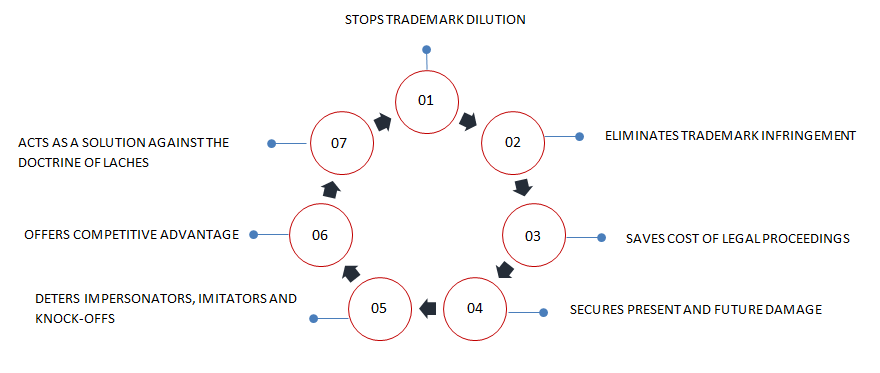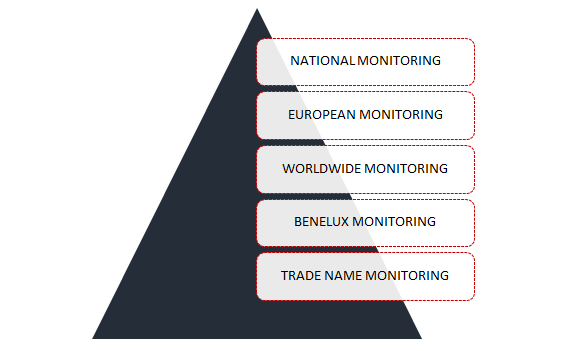A Guide to Trademark Monitoring
A trademark is an essential tool in establishing brand identity. In the age of cut-throat competition, unscrupulous players often disrupt a brand’s image by imitating an established brand name. Therefore, it is critical to watch out for and eliminate such activity through a dedicated service such as trademark monitoring. The service aims to keep an eye out for potential infringers and also checks whether your trademark is accidentally infringing on other trademarks. Trademark monitoring is critical for small as well as large businesses as no organization wants to squander crucial resources over avoidable trademark infringement lawsuits.
This article is a comprehensive discussion about trademark monitoring services, including when you need to avail the service, the benefits of trademark monitoring, pitfalls of not having a trademark monitoring plan, and much more. Let us begin by understanding what trademark monitoring really means.
Table of Contents
Trademark Monitoring
It is the constant process of tracking filed, advertised and accepted trademark applications to confirm that no marks, deceptively identical to yours, are being registered by anyone else.
It acts as a proactive step that preserves the brand equity and saves probably hundreds and thousands of dollars in lost revenue and costly trademark infringement lawsuits. Quite often, businesses make the mistake of addressing the issue of trademark infringement only when someone pulls their attention towards it. However, by then, the counterfeit products infringing on the trademark have already penetrated the market and damaged the brand image cultivated over many years.
Trademark monitoring service searches the web for infringement cases and sends a timely alert to the brand when there is a possible threat to be resolved. The task of monitoring can be carried out through a company or an individual, IP lawyers, or software that searches the web for your trademark. But trademark monitoring is a mammoth task. There are too many places to scour across the web to detect possible cases of trademark misuse. Moreover, personal websites could be challenging to find. Besides, online marketplaces, social media platforms are also common places for trademark infringement, where counterfeit products are bought and sold in abundance. Trademark monitoring software has the capability to search numerous sites globally, and is way more efficient and effective (in terms of both cost and time), when compared to manual scanning.
After understanding trademark monitoring, the first question that comes into mind is – when is the trademark monitoring service needed. The next section elaborates on this.
When is Trademark Monitoring Service Needed?
It is a common misconception that only large businesses and enterprises need to be concerned about trademark infringement. According to a study conducted by Smart Protection (a cyber-security company), four out of every five small and medium-sized companies across the globe are victims of brand abuse and counterfeiting on the internet. Therefore, irrespective of the size of your company, there is a high probability of your trademarks being infringed upon and misused on counterfeit products and goods. With e-shopping gaining popularity around the world, it has become easier to sell duplicate products online, and it is a growing danger that businesses need to be aware of. Trademark monitoring services are needed in the below-listed cases:
- When New Trademark Applications are Filed: Although governments worldwide offer trademark protection, they do not police potential violations. That is why the onus of protecting the IP rights falls on the owner of the intellectual property. In case you are worried about competitors or other businesses registering a similar trademark as yours, then the trademark monitoring service is an apt solution. It helps keep track of trademark applications filed by others, which are similar to yours. In addition, it enables to take punitive action at the right time.
- To Detect Possible Trademark Infringement: With the rising level of consumerism, brands are constantly competing for a larger market share. In the absence of a dedicated mechanism to detect infringers, it becomes challenging to eliminate such a hurdle. Trademark monitoring services are helpful for companies looking to protect their trademark rights and customer base by weeding out the imitators.
While performing trademark monitoring, many inexperienced players often commit the mistake of discerning the difference between trademark monitoring and watching. Trademark monitoring is unlike the watch service, which tracks the progress of a specific trademark application. Hence, if you want to follow a particular trademark filing, then trademark watching is the appropriate service to explore and avail. There is also a notable difference between trademark monitoring and trademark searching. Trademark monitoring is conducted once the mark has been registered to check for any same/similar mark placed before the registrar for registration. Trademark searching is performed at the starting point to determine if there is already a similar registered mark, or pending before registration for the same class of goods and services.
Now that you have understood what trademark monitoring means, it is time to delve into its myriad benefits.
Benefits of Trademark Monitoring Service
Trademark monitoring service serves numerous benefits, which are discussed in Figure 1 below:

1. Stops Trademark Dilution: Trademark dilution occurs when a trademark is used without authorization by its owner. The uniqueness and novelty of a trademark is seriously compromised by its unrestricted and unauthorized use. Trademark dilution can happen in more than one form, making it difficult to track and control. The trademark monitoring service helps keep a lid on the dilution activity and fends off widespread imitation.
2. Eliminates Trademark Infringement: Trademark monitoring searches the offline and online worlds for infringement cases and promptly alerts the concerned businesses of a likely threat. The use of exclusive trademarks without the consent/authorization of the owner, or license, qualifies as an act of trademark infringement. In an interconnected and hyper-competitive world, trademark infringement cases have been on a constant rise. To counter this threat, trademark monitoring has emerged as the preferred way for organizations. The service imparts greater efficiency to infringement search with the modern tools and technologies discussed later in the article.
Early detection of infringement cases and addressing the issues with the correct resolution can scale down the number of infringement cases in the future. An ordinary observer often confuses trademark dilution and infringement and uses them interchangeably. But in reality, there is major difference between the two. While infringement involves a level of customer confusion, dilution occurs with customers fully aware of the imitation taking place.
3. Saves Cost of Legal Proceedings: In the instance of trademark infringement, the hassle and cost associated with legal proceedings are very high. Early detection of infringement cases helps in saving resources, including money in the legal proceedings.
4. Secures Present and Future Damage Control: A low-value trademark lying at the bottom of the popularity list may command a much greater value in the future with an increase in demand. The trademark monitoring service helps to identify such low-lying trademarks with immense potential. The service results assist in developing a road map for thwarting probable present and future damages.
5. Deters Impersonators, Imitators, and Knock-offs: Acquiring and retaining a customer is a massive challenge for businesses, especially in the consumer age where switching loyalty is prevalent. Careful brand cultivation is one of the many ways to inculcate brand loyalty among your customers. Once the belief is developed, it is imperative to keep the impersonators, imitators, and knock-offs at bay through trademark monitoring service. Sustained monitoring helps spot imitators at early stages and take remedial measures before too much damage has been inflicted on the brand.
6. Offers Competitive Advantage: Trademark monitoring service offers valuable and actionable insight into your competitors in the market. During monitoring, there are instances when you might come across new developments that may prove crucial in acquiring a new customer base for your brand. Moreover, since a trademark is a strategic immaterial asset, it is pertinent to traverse competitor progress in the same domain.
7. Acts as a Solution against the Doctrine of Laches: The Doctrine of Laches is generally presented as a positive defense in a civil dispute. Its explanation prevents a party from raising any claim because of an unreasonable delay in enforcing the claim. The trademark monitoring service assists in detecting suspicious brands and trademarks at the preliminary stage, thereby preparing a rational argument against the Doctrine of Laches.
Now that you understand the benefits of a trademark monitoring service, we must also consider the drawbacks of not having a trademark monitoring plan in place.
Pitfalls of not having a Trademark Monitoring Plan
Ignoring a trademark for similar goods/services can cause irreparable damage to your previously distinctive mark. However, timely intervention with trademark monitoring service could protect your trademark’s distinctiveness and prohibit others from using the same. Therefore, an opposition raised on time may save time and money. On the other hand, if trademark misuse is not stopped, consumers could relate the new mark with the registered trademark, which may cause revenue loss and harm business reputation and goodwill. So, it is always advisable to regularly engage in trademark monitoring activity to search for possible misuse of a registered trademark. The three common pitfalls of not having a trademark monitoring plan are shown in Figure 2 below:

1. Fault line in Brand’s Uniqueness: Merely conceiving and creating a brand is not enough to protect it from infringers and imitators. Once you have registered an eye-catching brand, it is essential to preserve its uniqueness through trademark monitoring. In the absence of a concrete trademark monitoring plan, rampant product imitation is a common phenomenon that leads to a fault line in your brand’s uniqueness. The moment a brand loses its uniqueness, its customers start to switch loyalty, leading to a loss in revenue and market value.
2. Loss of Trademark Rights: The failure to constantly monitor your trademark allows for unchecked usage of your trademark. If this becomes rampant, the original trademark may fail to even serve as a brand identifier in some cases. Moreover, the use of your trademark by unauthorized third parties for an extended period may weaken your claim on the original trademark, and in the worst case, you may suffer from the loss of trademark rights. The situation becomes even more alarming if the imitator is a competitor with products and services similar to yours.
3. Brand Value Dilution: Brand building is a cumulative effort and takes years of diligent planning and execution. Trademark is a core part of the branding strategy. However, unauthorized and frivolous use of a trademark drastically affects the brand value. Customers often reduce their interaction with a brand that is no longer deemed worthy and novel. And besides customers, other stakeholders, such as suppliers, creditors, borrowers, etc., also show reluctance to engage in a long-term agreement with the business. In addition, brand dilution due to the absence of trademark monitoring causes an unseen loss of revenue.
Considering the risk associated with the absence of a trademark monitoring plan, it seems like a wise move to avail the service and its advantages. But before you do, it is important to understand the various types of services available.
Types of Trademark Monitoring Services Available
There are five different types of trademark monitoring services available, as shown in Figure 3 below:

- National Monitoring: This monitoring service is concerned with monitoring activity only for a specific country. It will check for infringement in your country of interest only.
- European Monitoring: If you are looking to monitor your trademark in the entire Europe region, European monitoring is the service to avail.
- Worldwide Monitoring: If your brand has global ambition and reach, it is wise to use the worldwide monitoring service.
- Benelux Monitoring: This provides monitoring services in three European countries, namely Belgium, Netherlands, and Luxembourg.
- Trade Name Monitoring: Instead of performing the trademark monitoring by jurisdictions, one can also perform the monitoring by trade name under contention.
Regardless of the type of monitoring service you opt for, it is also crucial to adopt appropriate tools for the desired results from trademark monitoring service. The next section elaborates on some of the most common tools that can help in trademark monitoring.
Tools used for Trademark Monitoring
- Google Ads and Keyword Planner: These two tools by Google are the perfect starting points to spot possible infringement of your trademark on the web by searching for specific terminology, phrases, and words. Google Ads, formerly known as Google AdWords, aid in finding out if a particular individual or organization has been misusing your registered trademarks to advertise and promote on the search engine. On the other hand, the Keyword Planner shares the outcome drawn whenever someone performs an online search using your registered trademark. This helps organizations/individuals identify other organizations seeking to reap benefits from their brand’s web traffic and online search volume.
- Google Search and Alerts: Despite being a standard tool that is used by millions of people across the world daily, Google Search can generate outstanding results when talking about checking the misuse of your trademark online. Besides, users can also use Google Alerts to get email notifications whenever new content with striking similarities with the original trademark appears online.
- Trademark Electronic Search System (TESS): This system utilizes robotized operations to detect trademark infringement even before it starts. The search engine filters suspicious trademarks depending on various variables. The United States Patent and Trademark Office (USPTO) maintains the TESS search system and assists in searching for registered trademarks and applications.
- Amazon Search: One should also conduct periodic searches on Amazon to see if your trademark is being infringed upon on online marketplaces. There have been instances of unscrupulous players riding on the success of an established trademark or brand using the slight variations in the name and selling these questionable products through e-commerce websites. It is important to eliminate such cases by conducting trademark monitoring on online marketplaces and taking suitable actions.
Apart from the above-discussed tools, new trademark monitoring software is also experiencing immense popularity.
Rise of Trademark Monitoring Software
Trademark infringement is such a widespread issue that it is a challenging task to monitor all violations. Some of the top-notch trademark monitoring software helps to find noticeably similar trademarks. The efficacy of all these monitoring software has even won the admiration of World Intellectual Property Organization (WIPO) which has recommended its use in practical applications. Compared to manual monitoring services, the software technology is way ahead in policing violations. Third-party service providers and law firms can leverage the software and send out cease and desist letters after being notified of infringement.
Trademark Infringement and Optimal Monitoring Policy
A trademark’s owner must take the responsibility of monitoring themselves to identify infringement and initiate legal action against the infringer. Mentioned below are some key factors in drafting an optimal monitoring policy.
1. Draft Clear Policies: Writing unambiguous agreements helps set parameters for terms of use of trademarks by partners. However, other players are often beyond the control of a trademark owner, such as lead generator, affiliate, third-party, or competitor. Clear policies that spell out what is allowed and what is not allowed, and the action taken for violating the policies brings out procedural consistency. Trademark owners can include the details of the following terms in the agreement:
- Allowed and restricted Keywords
- Permitted and prohibited ad copy
- Customized policies for different geography
- Use of trademark name in domain names, sub-domains, usernames, etc.
- Insert ‘detrimental to brand’ language
2. Determine Penalties for Non-Compliance: The penalties for non-compliance should be made abundantly clear in the agreement with the lead generators, affiliates, and partners. Third-party or competitors also feel discouraged from imitating when there are direct and transparent provisions for non-compliance. Any written agreement must plainly express that you monitor your trademark for violation and infringement. Besides, the agreement should state that the trademark enforcement will take place via an automated monitoring tool, so all concerned parties are acutely aware that active monitoring is in place.
3. Automate Trademark Monitoring Search: Manual trademark monitoring is the natural way to determine if you have a trademark misuse problem. Unfortunately, its inherent nature cannot be as holistic as an automated monitoring solution. The use of several evasive techniques such as geo-targeting and day-parting will cause the flow of valuable traffic from your site. Crawling and spotting thousands of identical/near-identical is best assigned to the prowess of technology and not humans. In the absence of an automated monitoring plan, monitoring is similar to ‘searching for a needle in a haystack’ — causing loss of time and resources.
4. Determine Responsibility: Before performing a trademark monitoring search, you should make critical decisions such as who is responsible for what. Ideally, there must be one dedicated team to check the outcome of the automated results. With time, the monitoring team becomes familiar with the tool. It can identify details from various consumer journey stages, such as ad copy, infringing ad, destination URL, landing page, etc.
5. Review and take Corrective Actions: Once the automated or manual results find out the trademark infringement case, the next step is to take corrective action. The actions may include contacting your affiliates and partners and reiterating the need to adhere to the agreement or imitating a violation case in instances where the infringer is a third party or a competitor.
Conclusion
In the absence of a comprehensive trademark monitoring plan, infringement and counterfeiting can cause long-lasting injury to your brands and related products/services. Early and sustained monitoring is vital to protect and enforce your trademark rights. Finally, considering the depth of the internet and advancement in technology, organizations and individuals must stay abreast of new infringement methods and solutions. The process of trademark monitoring must not remain stagnant to protect the interests of the trademark owners. Although many individuals and organizations perform the trademark monitoring in-house, it is advisable to outsource the job to a third-party service provider.
Sagacious IP strives to leverage the most advanced tools to deliver exceptional intellectual property solutions. Over the past few years, the company has accomplished many feats and expanded across four delivery centers with offices in six countries. In addition, its trademark monitoring service allows brands to keep an eye out for trademark infringement both globally as well as within the regions they operate in. Our dedicated team leverages conventional and non-conventional resources to keep track of possible infringement and enable customers to protect their valuable brand names. Visit the service page linked above to know more.
– Nitesh Chouhan (Trademark) and the Editorial Team
Having Queries? Contact Us Now!
"*" indicates required fields




